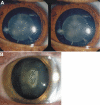A mutation in GJA8 (p.P88Q) is associated with "balloon-like" cataract with Y-sutural opacities in a family of Indian origin
- PMID: 18587493
- PMCID: PMC2435161
A mutation in GJA8 (p.P88Q) is associated with "balloon-like" cataract with Y-sutural opacities in a family of Indian origin
Abstract
Purpose: To detect the underlying genetic defect in a family with three members in two generations affected with bilateral congenital cataract.
Methods: Detailed family history and clinical data were recorded. Mutation screening in the candidate genes, alphaA-crystallin (CRYAA), betaA1-crystallin (CRYBA1), betaB2-crystallin (CRYBB2), gammaA-gammaD-crystallins (CRYGA, CRYGB, CRYGC, and CRYGD), connexin-46 (GJA3), and connexin-50 (GJA8), was performed by bidirectional sequencing of the amplified products.
Results: Affected individuals had "balloon-like" cataract with prominent Y-sutural opacities. Sequencing of the candidate genes showed a heterozygous c.262C>A change in the gene for connexin 50 (GJA8), which is localized at 1q21, that resulted in the replacement of a highly conserved proline by glutamine (p.P88Q). This sequence change was not observed in 96 ethnically matched controls.
Conclusions: We report a p.P88Q mutation in GJA8 associated with Y-sutural cataract in a family of Indian origin. Mutations of the same codon have previously been described in British families with pulverulent cataract, suggesting that modifying factors may determine the type of cataract.
Figures



Similar articles
-
Novel mutation in the gamma-S crystallin gene causing autosomal dominant cataract.Mol Vis. 2009;15:476-81. Epub 2009 Mar 4. Mol Vis. 2009. PMID: 19262743 Free PMC article.
-
A novel mutation in GJA8 associated with autosomal dominant congenital cataract in a family of Indian origin.Mol Vis. 2006 Oct 18;12:1217-22. Mol Vis. 2006. PMID: 17110920
-
A novel mutation in GJA8 associated with jellyfish-like cataract in a family of Indian origin.Mol Vis. 2008 Feb 9;14:323-6. Mol Vis. 2008. PMID: 18334946 Free PMC article.
-
A CRYGC gene mutation associated with autosomal dominant pulverulent cataract.Gene. 2013 Oct 15;529(1):181-5. doi: 10.1016/j.gene.2013.07.044. Epub 2013 Aug 14. Gene. 2013. PMID: 23954869
-
Clinical and experimental advances in congenital and paediatric cataracts.Philos Trans R Soc Lond B Biol Sci. 2011 Apr 27;366(1568):1234-49. doi: 10.1098/rstb.2010.0227. Philos Trans R Soc Lond B Biol Sci. 2011. PMID: 21402583 Free PMC article. Review.
Cited by
-
A G→T splice site mutation of CRYBA1/A3 associated with autosomal dominant suture cataracts in a Chinese family.Mol Vis. 2011;17:2065-71. Epub 2011 Aug 5. Mol Vis. 2011. PMID: 21850182 Free PMC article.
-
Inherited Congenital Cataract: A Guide to Suspect the Genetic Etiology in the Cataract Genesis.Mol Syndromol. 2017 Mar;8(2):58-78. doi: 10.1159/000455752. Epub 2017 Feb 7. Mol Syndromol. 2017. PMID: 28611546 Free PMC article. Review.
-
Another evidence for a D47N mutation in GJA8 associated with autosomal dominant congenital cataract.Mol Vis. 2011;17:2380-5. Epub 2011 Sep 1. Mol Vis. 2011. PMID: 21921990 Free PMC article.
-
A Novel CRYBB2 Stopgain Mutation Causing Congenital Autosomal Dominant Cataract in a Chinese Family.J Ophthalmol. 2016;2016:4353957. doi: 10.1155/2016/4353957. Epub 2016 Nov 29. J Ophthalmol. 2016. PMID: 28025620 Free PMC article.
-
Whole Exome Sequencing Reveals Novel and Recurrent Disease-Causing Variants in Lens Specific Gap Junctional Protein Encoding Genes Causing Congenital Cataract.Genes (Basel). 2020 May 6;11(5):512. doi: 10.3390/genes11050512. Genes (Basel). 2020. PMID: 32384692 Free PMC article.
References
-
- Lambert SR, Drack AV. Infantile cataracts. Surv Ophthalmol. 1996;40:427–58. - PubMed
-
- Reddy MA, Francis PJ, Berry V, Bhattacharya SS, Moore AT. Molecular genetic basis of inherited cataract and associated phenotypes. Surv Ophthalmol. 2004;49:300–15. - PubMed
-
- Scott MH, Hejtmancik JF, Wozencraft LA, Reuter LM, Parks MM, Kaiser-Kupfer MI. Autosomal dominant congenital cataract: Interocular phenotypic variability. Ophthalmology. 1994;101:866–71. - PubMed
-
- Vanita. Genetical investigations in congenital cataract cases. 1998; Ph.D. thesis, Guru Nanak Dev University, Amritsar, India.
-
- Amaya L, Taylor D, Russell-Eggitt I, Nischal KK, Lengyel D. The morphology and natural history of childhood cataracts. Surv Ophthalmol. 2003;48:125–44. - PubMed
Publication types
MeSH terms
Substances
LinkOut - more resources
Full Text Sources
Medical
Molecular Biology Databases
